
Publisher:
Bonnie King
CONTACT:
Newsroom@Salem-news.com
Advertising:
Adsales@Salem-news.com

~Truth~
~Justice~
~Peace~
TJP
Oct-14-2010 02:35

 TweetFollow @OregonNews
TweetFollow @OregonNews
Restoring the Tribal Balance: an Indigenous Solution for Peace in Afghanistan
Khalil Nouri Salem-News.comPart one in a special series.
 Flag over an Afghan military base at Jalalabad. Salem-News.com photo by Tim King. |
(SEATTLE) - We are New World Strategies Coalition (NSWC), a native Afghan think tank focused on nonmilitary solutions for Afghanistan. The white paper entitled "Restoring the Tribal Balance: An Indigenous Solution for Peace in Afghanistan", represents a game-changing exit strategy based on feedback from well-respected tribal elders.
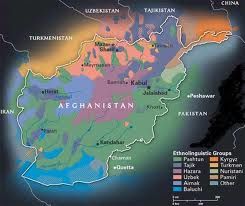 The NWSC's concepts have been covered by CNN, BBC and The Huffington Post and have garnered bipartisan support from Congressional leaders such as Dana Rohrabacher, Barbara Lee, Ed Royce and Duncan Hunter. It has also won the approval of former Pakistani and U.S. military and intelligence officials and even former members of the Taliban and Hezbi-Islami. The NWSC recently joined the Afghanistan Study Group (ASG), primarily because they lacked the input of native Afghans.
Above all, we truly believe there is only one solution for peace in Afghanistan - and it is an Afghan solution.
The NWSC's concepts have been covered by CNN, BBC and The Huffington Post and have garnered bipartisan support from Congressional leaders such as Dana Rohrabacher, Barbara Lee, Ed Royce and Duncan Hunter. It has also won the approval of former Pakistani and U.S. military and intelligence officials and even former members of the Taliban and Hezbi-Islami. The NWSC recently joined the Afghanistan Study Group (ASG), primarily because they lacked the input of native Afghans.
Above all, we truly believe there is only one solution for peace in Afghanistan - and it is an Afghan solution.
After thirty years of violence and chaos wrought by occupation, invasion and civil war due to external influence, we believe it's finally time to let the Afghans choose their own destiny.
EXECUTIVE SUMMARY
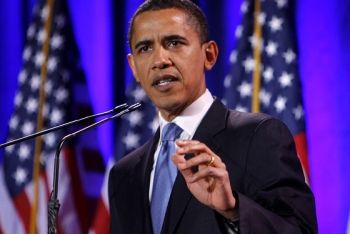
President Barack Obama doesn’t have a viable Afghanistan exit strategy due to a fatal flaw in America’s policy development process, which has been, namely, a complete lack of input from native Afghans. Because there is only one solution for peace in Afghanistan – and it is an Afghan solution.
The New World Strategies Coalition (NWSC) has the inimitable ability to gather feedback directly from tribal elders of well-respected clans in Afghanistan and, as a result, can channel the will of the Afghan people. The purpose of this white paper is not to specify a political solution but a process that will empower this “Silent Majority” so that Afghans can, finally, choose their own destiny.
Afghanistan experienced forty years of peace under King Zahir Shah during an era that began in the early 1930s. That type of society seems like ancient folklore in light of today’s conditions, because after 30 years of incessant war Afghanistan is now one of the most violent, corrupt and poverty-stricken places on earth.
The last time the Afghan nation saw anything that resembled stability was when its indigenous tribal structure was fully intact and a national unifying monarch sat on the throne - two essential factors that helped maintain the “tribal balance”.
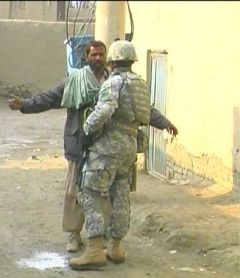 Photo by Tim King Salem-News.com |
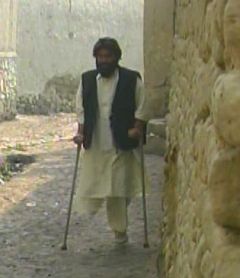 Photo by Tim King Salem-News.com |
The turmoil we see today is a direct result of foreign intervention that weakened the tribal balance, which can be broken down into the following periods: Soviet Occupation (1979 –1989); Afghan Civil Wars (1989 – 1994); Taliban Reign (1994 – 2001) and NATO Occupation (2001 – 2010).
General David Petraeus’s COIN strategy is designed for failure because of the stratospheric odds against winning Afghan hearts and minds primarily because the U.S. is aligned with a perceived corrupt and illegitimate puppet government in Kabul. Also, Afghanistan, with its tribal society and weak tradition of loyalty to the state, is not a promising place for a classic counterinsurgency operation.
Its twin goals of protecting the population and guiding the Afghan security forces toward self-sufficiency are inconsistent with Afghanistan's history, culture, and society.
If the root cause of the current dilemma is tribal imbalance, the obvious answer should be to reinstate this equilibrium. Thus, the NWSC is proposing a series of “All-Afghan Jirgas” be assembled to accomplish this mission. A total of three rounds of jirgas will be held to design and implement the solution – two meetings in neutral countries and the finale in Kandahar to announce the new government and head of state.
Other issues must still be addressed including neutralizing Pakistan and Saudi Arabia and addressing the drug trade. The next step would be to establish an independent commission of Afghan natives who would handle the logistics of the jirgas and act as a liaison between the delegates and the U.S. government.
INTRODUCTION
- Afghan Proverb
President Barack Obama wants an Afghanistan exit strategy – and he wants it now. Unfortunately, there doesn’t seem to be a viable solution on the table that will stabilize Afghanistan in the least or serve America’s national security interests. Some of the alternatives bandied about by senior administration officials are, unfortunately, formulas for state collapse - including the continuance of a 10-year-old failed counterinsurgency strategy, a Special Operations and C.I.A. drone war and a power-sharing solution that would divvy up the country amongst corrupt Afghan government officials, violent Islamic fundamentalists, mujahideen warlords and various other maligned actors.
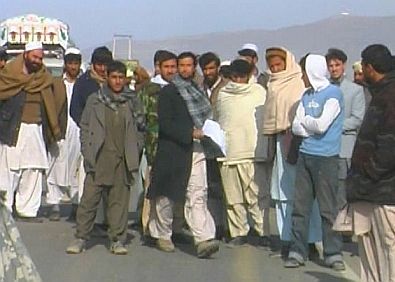 Photo by Tim King Salem-News.com |
A recent argument for a de facto partition of Afghanistan, recently brought to the debate by Robert Blackwill, a former policy advisor to both presidents Bush, would condemn the region to an endless ethnic conflict.
The fatal flaw in the Afghanistan policy development process has been the complete lack of input from the Afghan people - the stakeholders with the most to lose. The best-laid plans of global powers have failed miserably over the past three decades, and it is time for the U.S. and international community to come to the realization that there is only one solution for peace in Afghanistan – and it is an Afghan solution.
The aim of this document is to give Mr. Obama his exit strategy. The U.S. does not have to choose between President Hamid Karzai’s reprobate regime and the Taliban – there is another alternative. It might seem paradoxical but, although the U.S. and NATO should withdraw from the region because their mere presence is fueling the insurgency – they cannot leave.
Because there is one condition on the ground that must be met before the U.S. can drawdown, which is the implementation of an indigenous political solution that has the best possible chance of stabilizing the country.
AN AFGHAN PERSPECTIVE
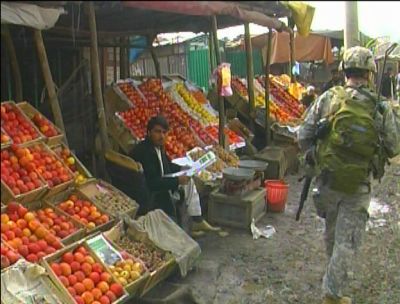 Occupied Afghanistan; U.S. soldier passes a fruit vendor in Kabul |
The concepts contained herein are radical in nature and one-of-a-kind because they reflect the thoughts and ideas of the Afghan people. This is important to note because the authors firmly believe the only way to end this war is with a complete indigenous Afghan solution – one with zero interference and participation from any other foreign entities.
Any remedy concocted must be designed by native Afghans and imbued with their tradition and custom, because, historically speaking, every other medicament imposed by foreign powers has exacerbated the situation, causing the country to rapidly deteriorate into an unrecognizable shell of what it once was.
External interference in Afghan affairs has resulted in nothing more than ultra-violence, radicalism, poverty, and the destruction of the very fabric of Afghan society. It is nigh time that Afghans are allowed to determine the fate of their own country by reconstituting the sacred unifying tribal structure that has been decimated by over 30 years of foreign invasion, incessant civil war and chaos.
This is the primary focus of the New World Strategies Coalition (NWSC), a think tank founded by Afghan expatriates who possess deep tribal connections. The group focuses on developing political, economic and cultural initiatives for Afghanistan, and unlike any other research institute around the globe, the NWSC - in partnership with other leading native Afghan scholars, experts and NGOs – produces truly indigenous scholarship and solutions.
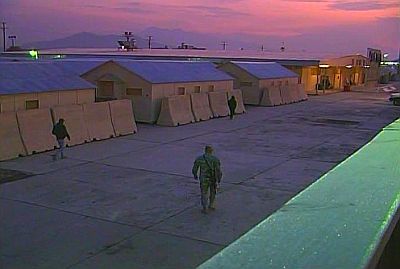 Sunrise at an American military base in Kabul, 2006 |
The NWSC is in a class by itself because it gathers direct feedback and “ground truth” through a communication network of tribal elders and representatives from some of the most well-respected tribes and clans in Afghanistan, and is thus able to channel the collective voice and will of the Afghan people.
This is an important point because the Obama administration, U.S. policymakers, military officials and congressional leaders have absorbed analyses and have made strategic decisions without the participation of and feedback from native Afghans, which the NWSC believes is a primary reason for America’s defective policies.
The reason the NWSC has a built-in advantage is fairly straightforward: the tribes will only disclose sensitive information to other Afghans whom they trust. This is for cultural and practical reasons. The cultural aspect is based on hundreds of years of anthropology and the practical reason is based on fear of reprisal from the powers that be.
To illustrate the value of its indigenous intelligence, the NWSC has been asked to testify before Congress on a couple of occasions. During one session in the mid-1990s, the NWSC warned the U.S. government about the rise of the Taliban. A senior congressman went so far as to say that if the U.S. had listened to the NWSC’s recommendations, 9/11 could have been prevented.
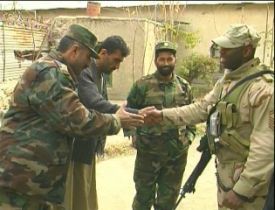 Moment of unity between east and west. |
This study is also unique because many of the NWSC’s members, being Afghan expats, serve both the American and Afghan people in their effort to bring peace and prosperity to a war-torn nation, which has been embroiled in a conflict that has caused both countries to lose much in terms of blood and treasure.
They see this mission as a moral obligation – undertaken not only on behalf of their forefathers’ homeland, but for love of their adopted country as well. And the unique Afghan-led solutions proposed herein have the potential to dramatically improve the lives of Americans and Afghans, and can positively alter the momentum and change the dynamics of the overall struggle.
The purpose of this white paper is not to actually specify a political solution, because the crux of the approach is based on Afghan native self-determination. Every significant political decision will be left up to the Afghan people in a series of jirgas. The NWSC’s goal is to outline an all-inclusive process and describe a tool that will empower the “silent majority” of the Afghan people, so they can, finally, choose their own destiny.
TRIBAL BALANCE: 40 YEARS OF PEACE
A FORGOTTEN ERA
 Women in Afghanistan, 1967 |
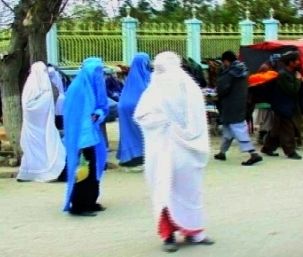 Women in Afghanistan 40 years later |
Once upon a time Afghanistan experienced a forty-year run of peace, stability and social progress during the reign of King Zahir Shah, an era that began in the early 1930s until a family coup ousted the King in 1973. That type of society seems like ancient folklore in light of today’s conditions, because after 30 years of incessant war Afghanistan is now one of the most violent, corrupt and poverty-stricken places on earth.
The before and after snapshots are mind-blowing, illustrating a near-incogitable contrast between what Afghanistan was like when it was left to its own devices and free from external intervention, versus its current state after being invaded, occupied and manipulated by foreign powers that have marginalized, weakened and corrupted centuries-old indigenous institutions and value systems.
Eyewitness accounts from the 60s and 70s document Afghan women wearing miniskirts at Kabul University. The sad truth is Afghan society had been in the midst of progressive reform and had been transforming itself, ironically, into an enlightened, modern, and democratic society.

One is challenged to find another example of a society that has experienced such dramatic economic, political, technological and cultural regression in such a short time period. Afghanistan has been bombed, decimated and hurled back centuries, and is now just a shell of the nation it once was. The challenge before the international community is to first accept and then figure out how to go back in time in order to go forward, while having the faith and moral courage to allow the Afghans to once again control and choose their own destiny.

TRIBAL STRUCTURE AND THE DYNASTIC PRINCIPLE
-Thomas Ruttig, Afghan Analysts Network
Replicating the exact form of government, laws, customs and rituals of this time period is not necessary, but there are certain aspects that must be reinstituted and strengthened, including sacred tribal tools and traditions so anthropologically ingrained in the Afghan people that they are indispensable to future stability.
These qualities and traits also serve to explain why the society-in-a-box being imposed upon the Afghan people by Westerners is anathema to the core fabric of the Afghans’ collective being.
The last time the Afghan nation saw anything that resembled stability was when its tribal structure was fully intact and a national unifying monarch sat on the throne - two essential factors that helped maintain what is referred to in this white paper as the “tribal balance”.
Throughout Afghanistan’s era of peace the government was based on indigenous principles, intuitions, custom and tradition. The state had been erected upon lessons learned through centuries trying to maintain peace within an insular acephalous tribal society with a penchant for infighting.
- Intra-tribal: cohesion at the family unit driven by tribal moral code called Pashtunwali
- Inter-tribal: balance maintained by common filial thread, national solidarity in times of crisis.
- Super-tribal: distribution of power and authority between the state sovereignty and the tribes (monarch-elites who derived power from moral authority)
Although weakened during the past few decades, tribal principles are still central to Afghan life, as the tribe continues to be the most integral political, economic, military and cultural unit in Afghan society.
The tribal belief system is also based on lineal and ancestral adoration and a near-religious belief in the royal bloodline. This kinship acted as a common thread that provided national solidarity and enabled the head of state to unify the tribes when necessary against external threats.
Afghanistan is still a hyper-fragmented and decentralized society. In the past, when the Afghan state was most functional, although it was technically a constitutional monarchy, the country resembled a “loose” confederation in which legislative and judicial powers were pushed down to the local level - a concept analogous to America’s states’ rights. So one can just imagine how Afghans view the Western-style uber-centralized government of President Hamid Karzai’s administration.
Congressman Dana Rohrabacher characterized how important a loose decentralized type of rule is for Afghans:
“Zahir Shah was the king of Afghanistan for 40 years and was successful because he didn't try to rule the entire country from Kabul. The King had a mandate from God- but he still let the people rule themselves locally.”
The tribal structure, moral code and kinship ensured not only intra-tribal cohesion but unified Afghans at the provincial and national levels as well. Common kinship and the respect for the King were critically important in stabilizing a country that could easily tip into chaos due to its fragmented nature.
The formal and informal power structures in Afghan society were relatively distributed and rarely abused. The tribes were vertically-structured and egalitarian in nature, in which decisions were made based on consensus-building as opposed to orders handed down from a hierarchical command structure.
And although tribal elders and leaders typically had the final say, they were able to become leaders in the first place because they had earned the honor of their respective tribes and derived their power from moral authority, not threat of violence. The inner-cohesion of the tribes was maintained by a moral tribal code that the Pashtuns referred to as Pashtunwali, which was based on tribal honor and pride, and also protected the rights of the individual.
This tribal moral code even trumped Islam in certain groups. Unique to Durrani Pashtuns was the fact that their ties to the monarchy established an aristocratic layer on top of the tribal structure. Thus, the monarch-elites had the relationship with the state, while the tribal elders ruled more locally. However, the monarch-elites also drew their power from moral authority based on filial kinship and respect for the royal bloodline.
Zahir Shah was a fine example of a unifying national figure who commanded support that cut across tribal and ethnic lines. He hailed from the Mohammadzai clan which fell under the sacred umbrella of the Duranni tribe – a tribe whose leaders ruled Afghanistan for over 200 years and who derive their name from the founding father of modern Afghanistan, Ahmad Shah Durrani. The Mohammadzais had always remained neutral, had no blood on their hands and no real enemies (at least with respect to Afghanistan, Pakistan’s Bhutto and the ISI are a different story). The King also had been adept at resisting “foreign entanglements” to ensure Afghanistan remained a “neutral buffer state”.
Unfortunately, two non-indigenous movements arose during the end of Zahir Shah’s rule: communism and a reactionary extremist form of Islamic fundamentalism which opened the path for 30 years of tribal destruction.
TRIBAL DESTRUCTION: FOREIGN INTERVENTIONS
30 YEARS OF FOREIGN INTERFERENCE
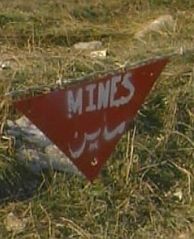 Sign at Bagram, Afghanistan |
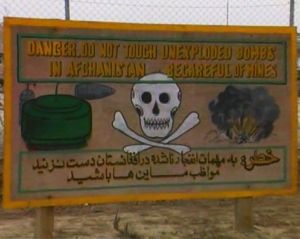 Sign warns of land mines at Kabul, Afghanistan |
If ever one needs a reminder as to the magnitude of the havoc wrought on the Afghan people, simply stroll through the countryside – but watch your step.
Afghanistan is still the most heavily landmined country in the world with 60 Afghans per month still getting blown up, most of them children who don't know what to look for as they play.
As a result, Afghanistan now has the highest percentage of disabled people in the world. The root cause of the turmoil we see today is that foreign intervention has weakened the tribal balance.
In order to properly analyze the symptoms that afflict Afghan society today it is important to understand the history and underlying causes of the country’s current decrepit state, which will also shed light on the animus towards foreign occupiers, especially the United States.
A consistent pattern formed of foreign actors attempting to impose non-indigenous systems of government, social programs and/or religions on a people infamous for resistance to external threats and influences. A quick summary of this can be found in figure 2.0 below.
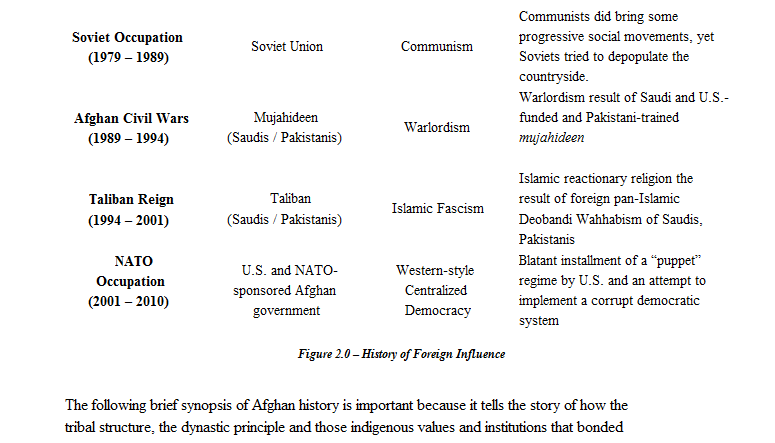
The following brief synopsis of Afghan history is important because it tells the story of how the tribal structure, the dynastic principle and those indigenous values and institutions that bonded Afghan society together were systematically destroyed, and how purported foreign ideological and religious panacea were actually contraindicative. The following critique, at times stinging, is based on the perspective of most Afghan natives and is a stark reality Western policymakers must come to terms with and weigh heavily during the decision-making process[1].
[1] http://www.rferl.org/content/article/1051546.html.
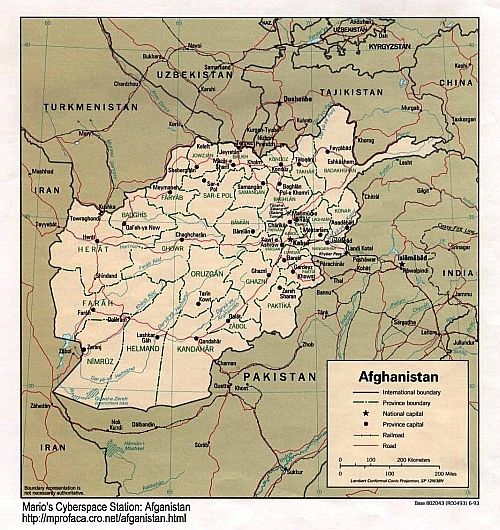
U.S. involvement in the annihilation of the tribal order cannot be overlooked, because tribal elders certainly haven’t forgotten. Most Americans are not aware of the fact that the U.S. and British intelligence agencies had been working together since the end of WWII to destabilize Afghan society. According to Elizabeth Gould and Paul Fitzgerald in Invisible History:
Afghanistan’s Untold Story, a Manichaean worldview and Cold War strategy retarded the expansion of anything that resembled communism or socialism – including movements such as nationalism, secularism and even, sadly, progressivism[2].
Indisputable proof exists that the U.S. fanned the spread of pan-Islamic extremism during the 1950s and 1960s, and helped facilitate the rise of groups like the Muslim Brotherhood primarily because the U.S. shared the same disdain for communists as conservative religious reactionaries. Through the Asia Foundation – a C.I.A. front – the U.S. funded Islamic extremist movements at Kabul University that eventually led to Afghanistan’s indigenous and moderate version of Islam being replaced by the sadistic fundamentalism we see today.
King Zahir Shah ended up the victim of historical circumstances, shackled to a century and a half legacy of colonial domination. Caught between the forces of communism, Islamic fascism and the geoplolitics of the Cold War his grand plans for progressive democratic reform were crushed and his country destroyed. Afghanistan played the role of geopolitical chessboard for U.S. Cold War strategy against the Soviets during the 1970s, a decade that ended with the U.S. and C.I.A. forcing the Soviets’ hand into invading Afghanistan to, as Jimmy Carter’s National Security Advisor Zbigniew Brzezinski put it: “give Russia its Vietnam”, as the U.S. went from Nixonian détente to Carterian confrontation.
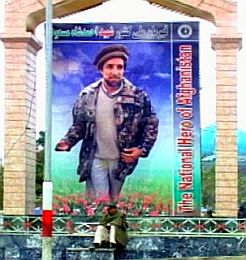 USSR fighter Ahmad Massoud |
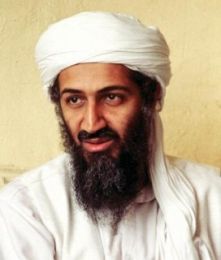 America's #1 bad guy Usama bin |
It is now no secret that the C.I.A., via Pakistan's Inter-Services Intelligence (ISI), funded and supported violent Islamic jihadists called the mujahideen in the Afghan war against the Soviet Union, providing them billions to procure weapons and recruit and train more jihadists.
After the Soviet retreat, these mujahideen “freedom fighters” became the very warlords that divided and terrified Afghanistan as it spiraled into civil war, moral decay and chaos, which led to conditions ripe for the rise of The Taliban and Al Qaeda.
The Taliban’s ultra-orthodox Islamic movement was actually a reactionary cause against the way the mujahideen had been practicing their form of Islamic extremism, because, apparently – it wasn’t extremist enough.
[2] http://www.citylights.com/book/?GCOI=8728610074126
After the post-9/11 takedown of the Taliban the U.S. abandoned Afghanistan by taking a detour to Iraq and leaving the country – once again – in the hands of warlords. This time the C.I.A. and U.S. military paid these miscreants millions upon millions to “secure and keep the peace”, which further corrupted the country. Thus, the rise of warlordism was yet another non-indigenous phenomenon that would have never taken root were it not for foreign meddling.
TRIBAL WEAKENING
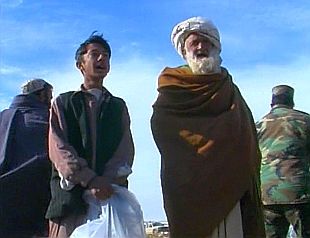 Tribal elder in a mountain village |
Kabul has fought against restoring the tribal balance since Karzai took office. The Karzai regime has not supported inter-tribal solidarity, even ignoring the decisions of local jirgas and shuras.
Reason being is that the Karzai clique is threatened by tribalism and sees it as much too egalitarian, instead preferring a form of patronage that is not inclusive but serves one side – their side.
The Taliban see the tribal code and custom as an affront to Islam, thus tribal conventions were further weakened during their reign as the chaos of the mujahideen warlords was replaced by religious fascism. The Taliban tried to establish Deobandi networks and replace tribal-centered villages with ulema and madrassa-centered structures.
Today they are continuing to uproot the tribal foundation, evidenced by their assassination campaign against tribal elders. In addition, according to Afghan expert Selig Harrison, “[S]ince 1979, the role of the hujrah [local secular community center] has been deliberately undermined by Pakistan and other countries including the United Kingdom and Saudi Arabia.”
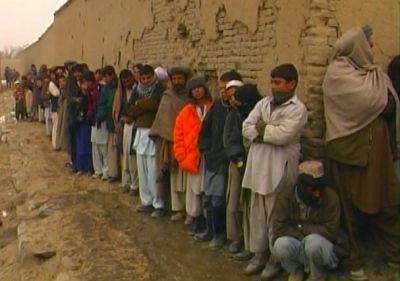 Kabul, Afghanistan. 2007 Salem-News.com photo by Tim King |
Harrison finds the coexistence and the interaction of the ancient tribal code of Pashtunwali with Islamic religious traits to be indispensible for understanding Pashtun culture:
“On the one hand, it explains the inevitable and ritualistic religiosity of a Pashtun, and on the other hand it explains the futility of efforts to inject religious fundamentalism in Pashtun social and political culture as it stands in contradiction to Pashtunwali. In fact, the Islamaic identity of the Pashtuns is only one thousand years old whereas Pashtunwali is reportedly five thousand years old.”
Societal fragmentation has been working in the Taliban’s favor. With the death of the dynastic principle and the absence of a well-respected national leader as head of state, Afghan society now lacks a common lineal thread that could unify the nation.
The implosion and degradation of the tribal structure directly spawned a sad new world now dominated by corruption, violence and poverty. 30 years of conflict resulted in a chain reaction that continues to work against any restoration of a valid state.
Tribalism and dynastic loyalty were principles that cemented the shards of clans and ethnicities together, enabling Afghanistan’s distinctive “regulated anarchy”.
But when these bonding agents were destroyed, Afghan society shattered and spiraled into an ever-darkening chaotic abyss, only to be exacerbated by U.S. policies similar to the ones that are arguably the root cause of the current state of affairs.
Here is part two in this special two part series. Oct-14-2010: An Indigenous Solution for Peace in Afghanistan Part 2 - Khalil Nouri Salem-News.com
 Born in an Afghan political family belonging to the Mohamadzai clan of the Pashtun Durani confederacy, Khalil's father, uncles, and cousins were all career diplomats in the Afghan government. His father's diplomatic career led to time in Moscow, Pakistan, London and Indonesia. Throughout all this time, since the 1960’s, Khalil grew to be exposed in Afghan politics and foreign policy. During the past 35 years he has been closely following the dreadful situation in Afghanistan. His years of self- contemplation of complex Afghan political strife and also his recognized tribal roots gave him the upper edge to understand the exact symptoms of the grim situation in Afghanistan.
Born in an Afghan political family belonging to the Mohamadzai clan of the Pashtun Durani confederacy, Khalil's father, uncles, and cousins were all career diplomats in the Afghan government. His father's diplomatic career led to time in Moscow, Pakistan, London and Indonesia. Throughout all this time, since the 1960’s, Khalil grew to be exposed in Afghan politics and foreign policy. During the past 35 years he has been closely following the dreadful situation in Afghanistan. His years of self- contemplation of complex Afghan political strife and also his recognized tribal roots gave him the upper edge to understand the exact symptoms of the grim situation in Afghanistan.
In addition to his role as a Salem-News.com contributor, Khalil is a guest columnist for Seattle Times, McClatchy News Tribune, Laguna Journal and a staff writer for Veterans Today. He is the cofounder of NWSC Inc. (New World Strategies Coalition Inc.) a center for Integrative-Studies and a center for Integrative-Action that consists of 24- nonmilitary solution for Afghanistan. You can write to Nouri Khalil at this address: khalil.nouri@gmail.com
Articles for October 13, 2010 | Articles for October 14, 2010 | Articles for October 15, 2010



Quick Links
DINING
Willamette UniversityGoudy Commons Cafe
Dine on the Queen
Willamette Queen Sternwheeler
MUST SEE SALEM
Oregon Capitol ToursCapitol History Gateway
Willamette River Ride
Willamette Queen Sternwheeler
Historic Home Tours:
Deepwood Museum
The Bush House
Gaiety Hollow Garden
AUCTIONS - APPRAISALS
Auction Masters & AppraisalsCONSTRUCTION SERVICES
Roofing and ContractingSheridan, Ore.
ONLINE SHOPPING
Special Occasion DressesAdvertise with Salem-News
Contact:AdSales@Salem-News.com

Terms of Service | Privacy Policy
All comments and messages are approved by people and self promotional links or unacceptable comments are denied.
Joe April 3, 2012 8:43 am (Pacific time)
This article give a complete pass to the Soviet Union and it's designs and era of destroying Afgan society.
[Return to Top]©2025 Salem-News.com. All opinions expressed in this article are those of the author and do not necessarily reflect those of Salem-News.com.